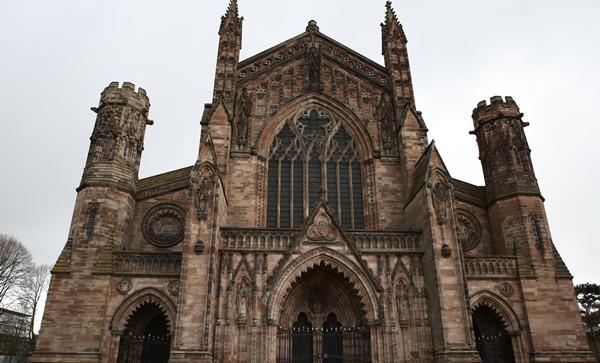The Chain Library of Books in Europe (01:14)
Who says stealing a book is not stealing! Book thieves are cursed, for example, in the Arnstein Bible, which was completed in Germany in the twelfth century and is now in the British Library, it is written: "If someone takes this book, let him die - let him fall into the pot and be fried - make him sick with fever - let him be hit by a car - and then hanged." amen! (The Arnstein Bible, British Library MS. Harley 2798,fol. 235v)。 However, not everyone believed in the power of curses, so one of the simplest and most brutal ways to do it was to put a chain on a book. This not only does not affect people's reading, but also ensures that the book will remain safely in the library for the rest of their lives. Thus was born the Chain Library. Such libraries were particularly common in Medieval and Renaissance Europe. Today, only a few chain libraries in the world have survived. The Chain Library at Hereford Cathedral in England is one of the most famous. Spring was in full bloom in April, and I decided to find out.

Hereford Cathedral
Chained library entrance
I imagined the smell of old books in the air in the dark, damp church, the sunlight shining through the stained-glass windows, the colorful shelves of the old books, continuing to guard the centuries of secrets. In fact, when I arrived at the scene, I found that the chained library of Hereford Cathedral was neat and bright. The library staff told me that in order to better protect these ancient books, about 26 years ago, the chain library was relocated to this room tailored for it, and "neighbored" with the world-famous Hereford map. On 3 May 1996, the Queen opened the library. The museum currently houses about 1,500 books, including 229 medieval manuscripts, and more than 80 books from the 12th century. Important collections include parts of St. Francis's College, which was seized in 1679, the library of the Priests' Choir of Hereford Cathedral, and the chain library of All Saints' Church hereford.
The History of the Hereford Cathedral Library dates back to the early 11th century. In 1055, a conflict over the land destroyed the church, and only one book survived, the "Gospel of Hereford", which is probably the oldest surviving book made in Wales. In the 12th century, the reconstruction of Hereford Cathedral was accompanied by the reconstruction of the library, which had always been an integral part of the church's development into a local learning centre. In 1582, the Queen's Council found the library neglected and decided to protect it. In 1590, the library was moved from the cloister to the cathedral's Chapel for Women. By 1597, all books were chained. According to the cathedral's records, the construction date of the chain library was around 1611. The move was advocated by the church pastor Thomas Thornton (1541-1629), pastor of Christ Church, Oxford, and curator of the Hereford Cathedral Library. Thornton was familiar with the Duke Humphrey Library of Oxford University and most likely was involved in the renovation of the library that began in 1610. He insisted that the Hereford Cathedral Library should be "no less than the Library of Oxford". The chained library remained in the cathedral's chapel for women until 1841, when the eastern end of the church was renovated.
What I found was different from the usual library displays: the books were facing outwards and the spines were inward, while one end of the chain was fixed to the envelope near the edge of the book, and the other end was fixed to the iron rod of the bookshelf. The staff explained that when the book was taken down and read, the chains would not be tangled together. Because of the chains, books can always only be "active" near the shelves, that is, the reader must read the books near the shelves. In addition, even if the book is removed from the shelf, the librarian needs to use the key to open the lock at one end of the shelf. It seems that borrowing chain books to read is really not an easy task. I'm curious, without seeing the spine, without knowing the title, how can the borrower find the book he wants to read? That's when I noticed that each bookshelf had a table of contents at one end. The staff explained that usually the librarian knows the location of the book and asks them about it.
Interior of the chain library
One end of the chain is fixed to the book cover
Dense chain books
The other end of the chain is fixed to the iron rod of the bookshelf
Bookshelf catalog
The staff explained to visitors how to read the Book of Chains
Many people first came into contact with Chain Book through the TV series "Game of Thrones". In the first episode of the seventh season, chubby Sam comes to Schooltown, where he organizes books every day, cleans up, and reads forbidden books privately... Taking advantage of this opportunity, everyone can peek into the library of the supreme governing body of the bachelors of the Seven Kingdoms, and one of the shots in the library is the chain book. This seems to convey the message that those in power hold books, that is, knowledge, and that only a privileged few have access to it. This reminds me of the famous saying that never goes out of style: Knowledge is power. When you have knowledge, you become strong. Well, go read a book. Chains can prevent people from stealing books, but they can't prevent generations from mastering the knowledge in books.
(Cui Ying: Journalist, documentary filmmaker, columnist, PhD from the University of Edinburgh, loves walking and literature, likes to collect old illustration books from all over the world, and has published books such as "British Illustrators" and "British Illustration Book Collection". )